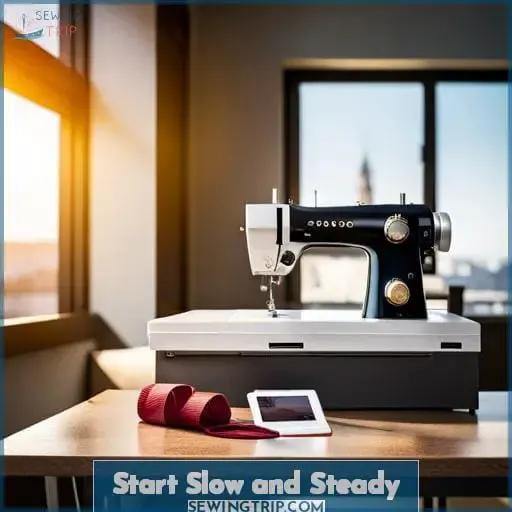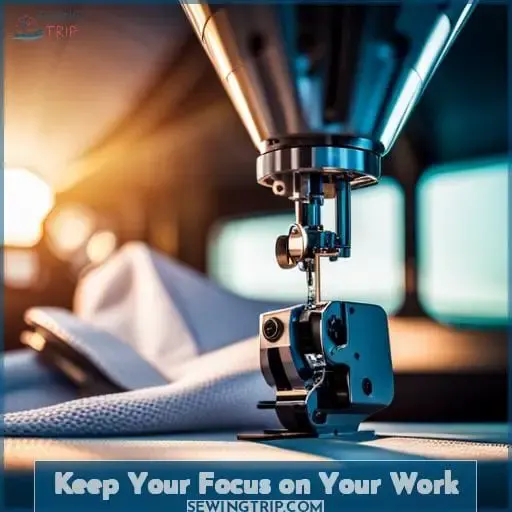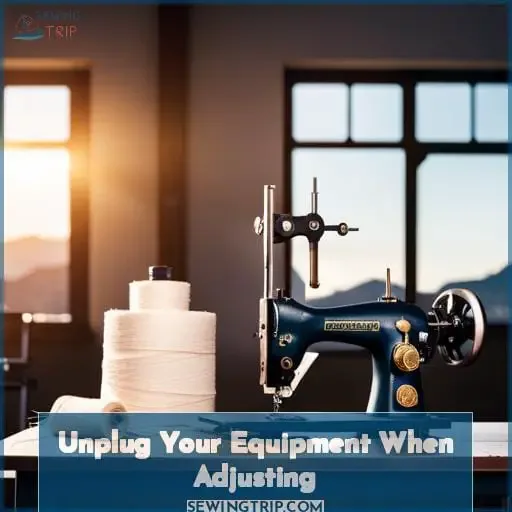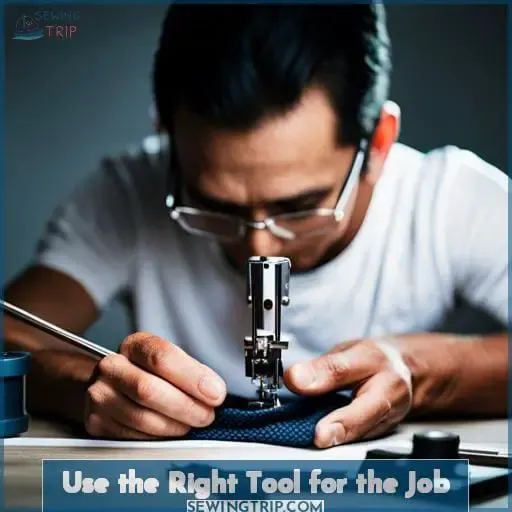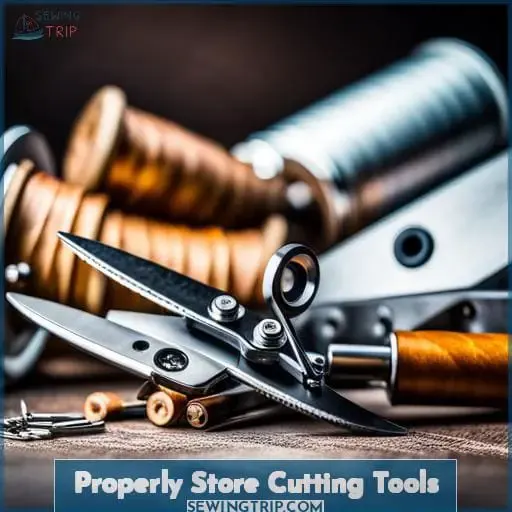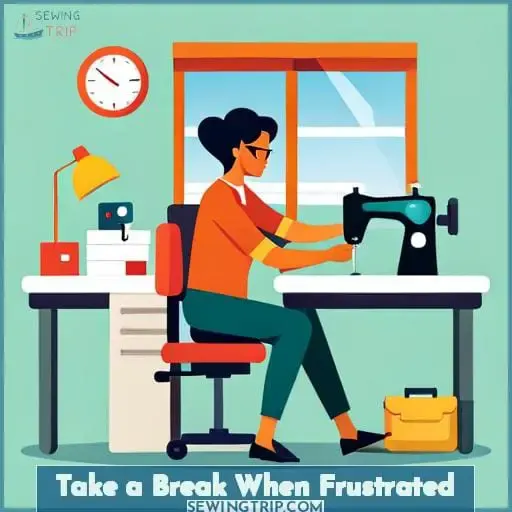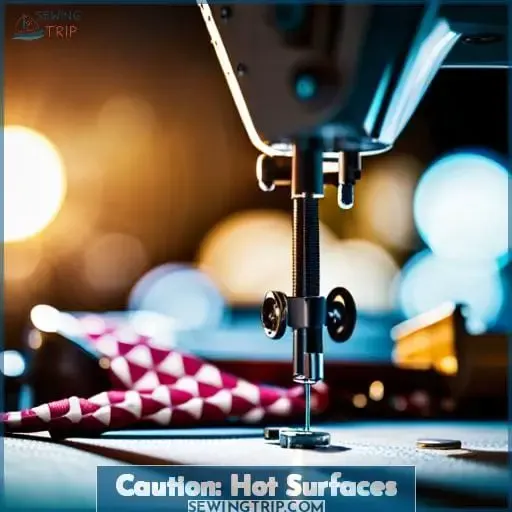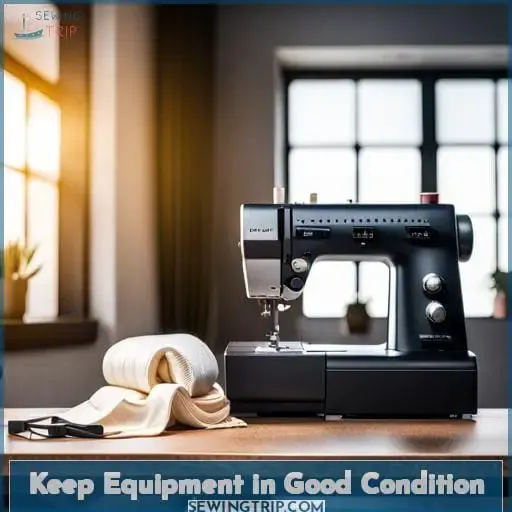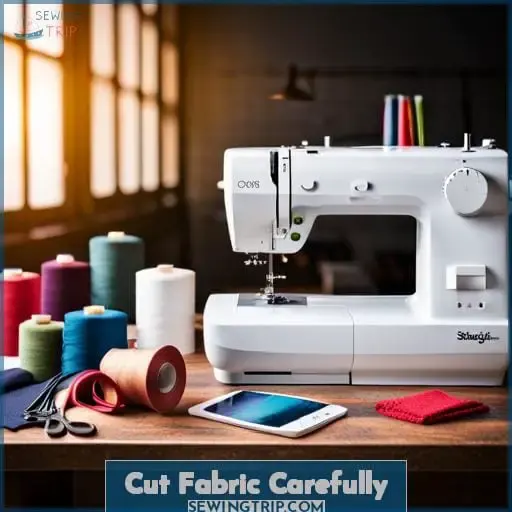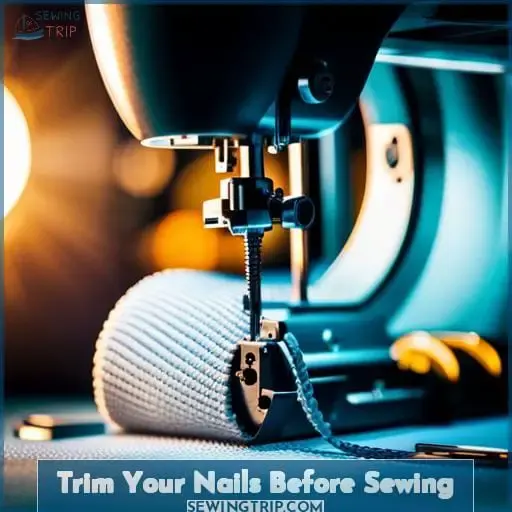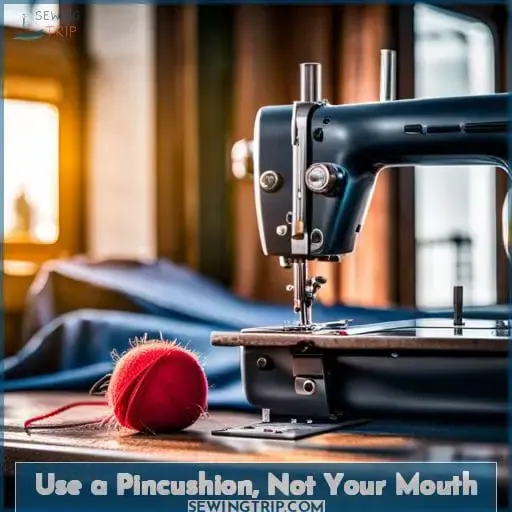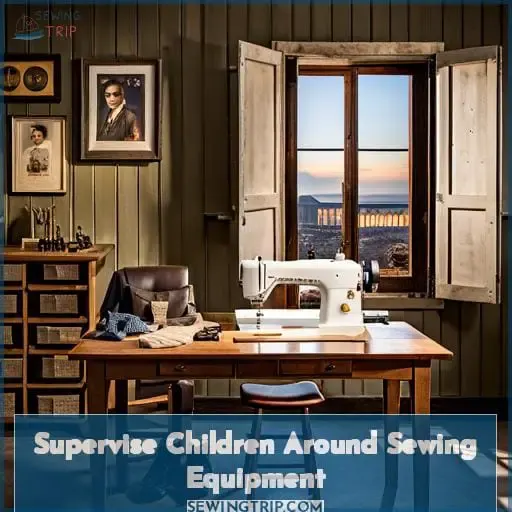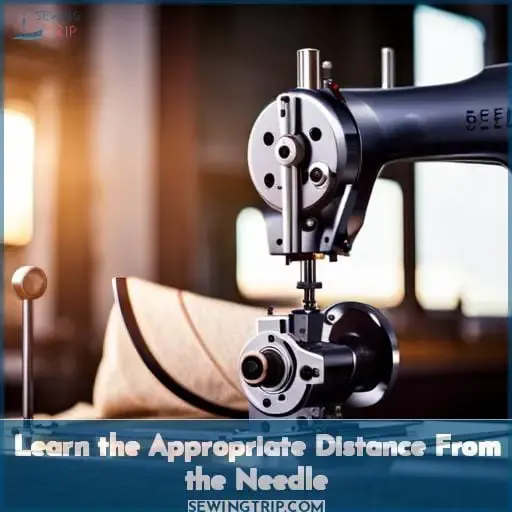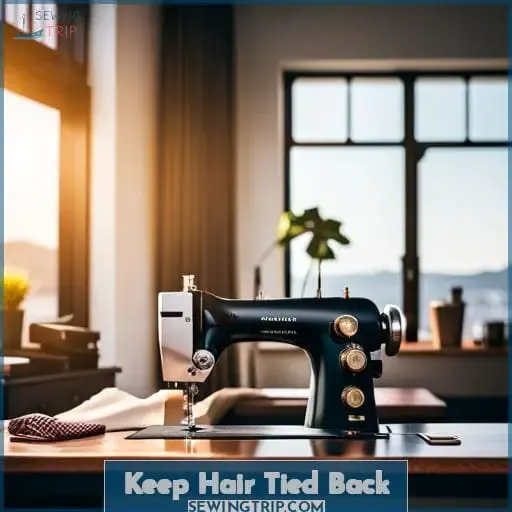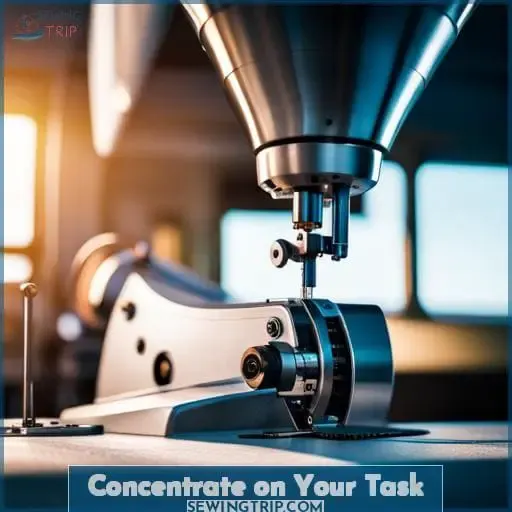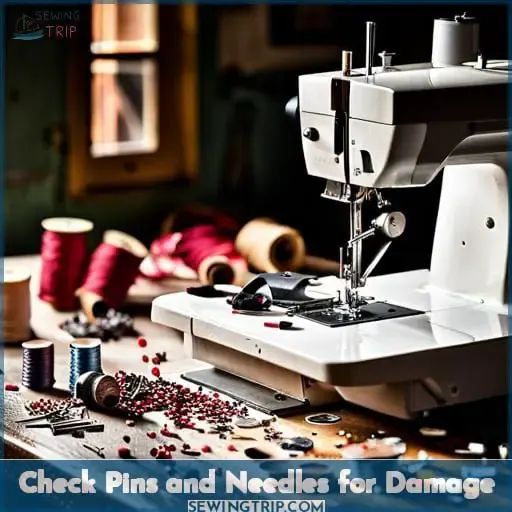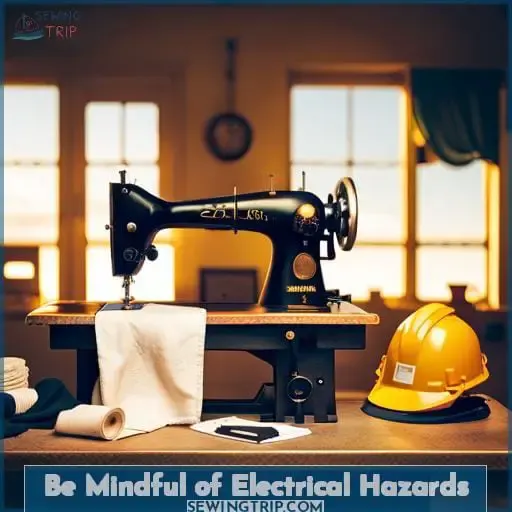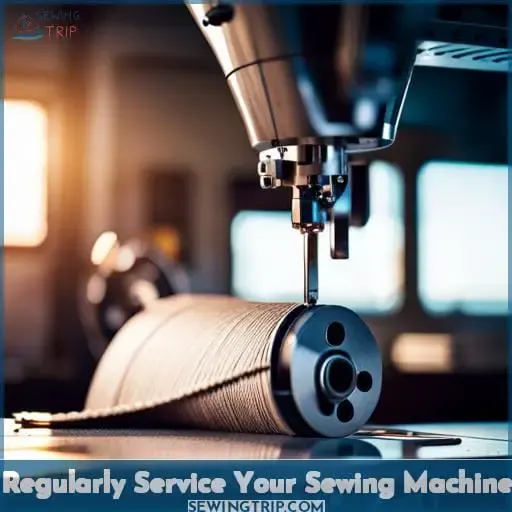This site is supported by our readers. We may earn a commission, at no cost to you, if you purchase through links.
Sewing is an art form that has been around for centuries. It can be a fun and rewarding hobby, but it’s also important to remember the safety precautions that come with this craft. Knowing how to protect yourself and your equipment will ensure you have a safe sewing experience every time.
With the right knowledge and skills, you can not only sew confidently but also masterfully! Let’s take a look at what safety measures are necessary when sewing so we can all enjoy this creative pursuit without worry or danger.
Table Of Contents
- Key Takeaways
- Start Slow and Steady
- Keep Your Focus on Your Work
- Unplug Your Equipment When Adjusting
- Use the Right Tool for the Job
- Properly Store Cutting Tools
- Take a Break When Frustrated
- Caution: Hot Surfaces
- Keep Equipment in Good Condition
- Cut Fabric Carefully
- Trim Your Nails Before Sewing
- Use a Pincushion, Not Your Mouth
- Supervise Children Around Sewing Equipment
- Plan Your Sewing Space Carefully
- Learn the Appropriate Distance From the Needle
- Keep Hair Tied Back
- Concentrate on Your Task
- Check Pins and Needles for Damage
- Never Sew Over Pins
- Use the Right Machine for the Fabric
- Be Mindful of Electrical Hazards
- Listen to Your Machine for Warning Signs
- Regularly Service Your Sewing Machine
- Always Turn Off Your Machine When Not in Use
- Frequently Asked Questions (FAQs)
- Conclusion
Key Takeaways
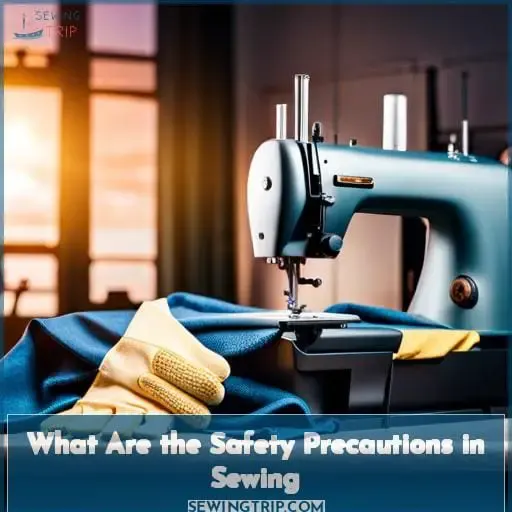
- Safety measures are crucial in sewing, including being mindful of hot surfaces and handling fabric with care to avoid accidents.
- Proper needle maintenance and thread selection, as well as using the appropriate needle size for the fabric type, are important for safety.
- Regular maintenance and inspection of all components of the sewing machine, as well as listening for warning signs of potential problems, can prevent accidents.
- Distractions should be avoided, and a focus on the task at hand with ground rules for safe handling of materials and tools can ensure optimal focus and accuracy.
Start Slow and Steady
When starting a new sewing project, take it slow and steady to ensure you get the best results! Keep your distance from the sewing machine while in use, as well as any other sharp objects.
Be mindful of hot surfaces such as ironing boards and steamers that can cause burns if touched accidentally. Pick the right type of machine for each fabric material since some fabrics may not be compatible with certain machines, which can result in damage or poor stitching quality.
Ensure electric hazards are avoided by unplugging appliances before making adjustments or repairs and keeping wires away from water sources when possible.
Remember that safety is paramount, so sew at much slower speeds than normal until becoming familiar with equipment operation techniques. Finally, remember that regular maintenance is key for optimal performance. Lubrication helps protect moving parts against stress-related wear, which could lead to hazardous malfunctions down the line.
Keep Your Focus on Your Work
Now that you’ve got the basics down, it’s important to keep your focus on your work. This is especially true when using sewing machines. It can be easy to become distracted and lose track of what you’re doing, but this could lead to serious safety issues if something goes wrong.
To ensure a safe experience with your machine, always make sure that mental concentration is top priority while working. Additionally, take into account electrical safety by making sure all cords are in good condition and away from any water sources or sharp edges of fabric during use.
When selecting a type of fabric for each project, also consider the type of needle used as well as proper machine maintenance techniques before beginning any project with a sewing machine for optimal results and benefits from focusing on the task at hand! Good advice like properly caring for cutting tools such as scissors or blades should never be overlooked either; they are just as essential in ensuring proper care throughout projects too!
Unplug Your Equipment When Adjusting
Always unplug your equipment before making adjustments to avoid potential hazards. When sewing, it’s important to remain aware of the dangers associated with electric machines and sharp needles, as well as other tools such as rotary cutters and hot irons.
- Consistent Maintenance – Regularly check that all components of your machine are in good working order. This means general maintenance like oiling or cleaning should be done regularly.
- Proper Supervision – If children will be present during any part of the process, ensure they understand safety precautions needed when around a new sewing machine or other sharp objects.
- Needle Awareness – Make sure you know how to safely use needles while avoiding contact between them and skin whenever possible.
- Electric Safety – Pay attention when using electricity near water sources and never leave cords unattended without proper supervision.
Use the Right Tool for the Job
Choose the right tool and don’t be a fool, or you’ll regret it later! Safety is key when it comes to sewing. Quality tools are essential for safe handling both of fabric and machine parts. Improper maintenance can easily lead to accidents, so make sure your equipment is always in proper working order.
Before starting any project, select the right fabric according to its specific needs. Stretchy fabrics need special needles, while heavier ones require more heavy-duty machines, etc. Electric precautions should also be taken into account. Unplugging your machine before adjusting settings will help prevent injury from electric shock or sudden movements caused by an unexpected start-up of machinery.
All these steps may seem tedious, but following them ensures safety as well as quality results every time you work on a project! Use thread nippers instead of scissors for trimming threads since they provide better control over each cut.
Knife blocks protect pointy needles that could otherwise harm unsuspecting hands and fingers if left out in plain sight (or reach).
With all these easy steps taken into account, there’s no reason why one cannot enjoy successful sewing projects without risking personal safety.
Properly Store Cutting Tools
Store your cutting tools in a safe place when you’re not using them. This includes not only scissors, but rotary cutters and other items like straight edges or rulers that are necessary for precise cuts.
Professional tailoring shops usually have specially designed tables with cutting mats on top to protect the fabric while being handled by people of all ages, so consider investing in one if possible.
Always use a dedicated piece of scrap fabric underneath the material you wish to cut. This will help prevent slips and mistakes during handling, which could lead to injuries or accidents.
Make sure electric safety is never overlooked either: unplug any equipment before adjusting it!
Finally, always practice proper care when handling fabric as well as maintaining focus at all times.
Proper storage of these essential tools is key for everyone’s safety, no matter what their age may be!
Take a Break When Frustrated
Take a break when you’re feeling frustrated while sewing – it’ll help you stay focused and productive. A few minutes away from the task can make all the difference in preventing accidents.
It’s also important to be mindful of machine maintenance, fabric selection, and snagging nails with rough edges.
When setting up your sewing room, make sure there is some breathing space between machines and other tools.
Taking regular breaks will keep things running smoothly–emotionally as well as physically–so don’t forget about them.
Caution: Hot Surfaces
Be mindful of hot surfaces when sewing, such as steamers and irons, to avoid injury. Always read the manufacturer’s instructions carefully and use them according to safety guidelines. It is important to select the right fabric for your project so it does not get damaged by heat from these tools.
Test how much heat will be transferred onto your fabric prior to starting a project with an iron or steamer. Ensure pins are secure before applying any heated surface; this can prevent accidents if they become loose while heating fabrics.
To avoid electric shock, visit your local craft store for information about proper usage and care of electricity-powered machines like sewing machines. Tying back long hair is also highly recommended. By following safety procedures and being aware of potential hazards associated with hot surfaces during sewing projects, everyone can stay safe.
Keep Equipment in Good Condition
Make sure to always keep your equipment in top-notch condition so you can enjoy smooth, hassle-free sewing! Allowing your machine and tools to become dull or broken could put both you and your fabric at risk.
- Create a maintenance schedule that fits with the workings of your sewing machine.
- Regularly clean needles, bobbin casings, and other parts after use.
- Have a fitting room dedicated solely to checking patterns before beginning the project.
- Inspect all pins, needles, and thread often for potential danger such as rust or a broken needle.
No matter what level of experience one has when it comes to sewing, safety should be taken seriously by everyone.
Cut Fabric Carefully
Always handle fabric with care when cutting to avoid accidents. Before starting, make sure your blade is sharp and in good condition. Dull blades can cause the fabric to bunch up or slip, leading to uneven cuts and potential injury.
When cutting, use a steady hand and keep your fingers away from the blade’s path by placing them on top of the ruler or template you are using as a guide. Be mindful of stitch settings that may affect how much pressure is applied during sewing – adjust accordingly for more delicate fabrics like silk or chiffon.
Here’s an example table showcasing different types of fabrics along with their recommended needle size:
| Fabric Type | Needle Size |
|---|---|
| Denim | 90/14 |
| Knits | 75/11-90/14 |
| Silk | 60/8-70/10 |
In addition to proper needle maintenance and thread selection based on fabric quality, tool safety is also crucial when it comes to avoiding injuries while sewing.
Lastly, always maintain a safe distance between yourself and others while working with machinery – this means keeping children supervised at all times too!
Remember that taking simple steps towards ensuring safety will allow you peace of mind throughout every part of creating your own version garment–and that’s not just important for efficiency but also overall well-being!
Trim Your Nails Before Sewing
Trim your nails to avoid snagging the fabric while you sew. It’s a simple step that can save you from huge frustration when it comes to sewing!
Annabelle Carter Short of Threading Tips says, A simple slip of the hand is all it takes for one small snag!
Needle selection and proper machine maintenance are essential components for safety precautions in sewing. To ensure your work surface remains safe, select needles based on their size and shape according to what kind of material or fabric preparation technique will be used.
When using a sewing machine, always remember that even though they may look like innocent machines, they are some of the most dangerous tools around with moving parts at high speed!
Taking care during cutting is also important: use sharp scissors instead of dull ones; keep them away from children; store them properly after each use; and take frequent breaks if needed!
With these basic tips in mind, anyone can create beautiful garments with confidence knowing they have taken every precaution necessary for optimal safety results while working with their favorite fabrics – happy stitching!!
Use a Pincushion, Not Your Mouth
Keep pins and needles in a pincushion, not your mouth! This is one of the most important safety tips that craft lovers should practice today.
Not only can it be dangerous to have sharp objects like pins or needles near your face, but you also risk accidentally swallowing them if they are kept too close. Instead, opt for a small cushion specially designed for storing these items safely while sewing.
People who take on projects involving machines must learn their settings correctly before use and always tie back long hair to avoid getting tangled in the needle or other parts of the machine. Additionally, keep all equipment clean while working and make sure to unplug any tools after finished using them.
Electricity can still remain when plugged in, even with no activity occurring on screen displays such as LED indicator lights being lit up.
Learning how to sew properly requires knowledge about both fabric types used as well as correct tool usage. Following basic safety tips mentioned earlier will help ensure that people stay safe throughout their projects without any injuries caused by negligence or lack of understanding regarding proper procedure(s).
Supervise Children Around Sewing Equipment
Be sure to supervise children when they are near any sewing equipment, as a few seconds of inattention can be dangerous. It is important to practice safe storage and proper care for all machines used around children.
Ensure the machine is properly unplugged from electrical outlets before allowing kids access and teach them about electrical awareness so that they understand how potentially hazardous it can be.
Regular maintenance should also be done on machines, which will help prevent any dangerous situations or accidents due to incorrect operation or malfunctioning parts.
Children’s safety should always come first when handling anything related to sewing.
Plan Your Sewing Space Carefully
Take the time to plan your sewing space carefully for a smoother, more enjoyable experience! A well-thought-out workspace is essential for avoiding potential injuries while you sew. First and foremost, safety should always be at the forefront of your mind when it comes to operating any equipment or tools related to sewing.
Make sure you have all of the proper equipment necessary in order to maintain focus intently on each task without interruption. Also, ensure that you know your limits as far as what type of fabric can handle with which machine or tool.
When planning out how much room will be needed, consider where items such as cutting boards, irons, scissors, etc., will fit comfortably in relation to one another. But also keep an eye on where cords are located so they don’t get tangled up during use.
As our last tip, remember that it doesn’t hurt to take some extra precautions along the way when dealing with any kind of machinery-related tasks – especially those involving electricity.
Learn the Appropriate Distance From the Needle
Stay aware of the proximity of your hands to the needle as you sew. It is one of the most obvious risks when it comes to sewing safety, so being conscious and careful about how close you are to it can help avoid any unfortunate accidents.
- Avoiding Pins: Always keep pins away from where they could get caught in your fabric or end up too close for comfort near the needle.
- Electric Safety: Make sure all connections and cords remain secure while in use and check settings before starting any project.
- Machine Maintenance: Regularly oiling components will help reduce wear on individual parts which makes them last longer over time spent sewing.
In addition, make sure hair is tied back securely; choose fabrics carefully based on their compatibility with your machine; take frequent breaks if feeling tired or frustrated; and finally, don’t forget other items like trimming nails short so they won’t snag threads during stitching projects.
Taking steps such as these may seem mundane but can ultimately save time by avoiding costly repairs down the line due to negligence or lack thereof regarding safety precautions while sewing.
Keep Hair Tied Back
Secure your hair by tying it back while sewing to minimize distractions and stay focused on the task. This helps keep you from getting tangled up in thread and ensures no stray hairs get caught in moving parts of the machine.
It is especially important when using a serger or overlocker as they move fabric quickly, making it easy for loose strands to become entangled.
Avoid substances that can affect focus, such as alcohol and energy drinks, before tackling any project.
Regular maintenance of your sewing machine will not only make sure everything runs smoothly but also prevent potential accidents like needle breakage due to worn-out parts or malfunctioning machines due to improper settings caused by blocked lint traps, etc.
Lastly, be sure to turn off all equipment when finished with a project. What may seem like an insignificant step can save you from terrible outcomes! Taking these simple precautions not only ensures safety while creating garments but also gives us confidence knowing our hard work won’t go down the drain after spending so much time sewing something up!
Concentrate on Your Task
Focusing on the task at hand is key while sewing, as distractions can lead to potentially dangerous mistakes. To sew safely and effectively, it’s important to be motivated and inspired by the creative process.
Follow instructions closely for best results. If you’re new to a particular technique or pattern, take more time to study them before beginning your project. Avoid distractions such as TV or conversations with others that could pull your attention away from what you’re doing.
Staying positive will help keep focus and concentration levels high so necessary safety precautions can be taken into account without any hindrances during work progressions. Use protective equipment such as gloves when handling sharp tools like scissors or needles.
Take frequent breaks between working sessions too. All these steps combined ensure safe practices while attaining desired outcomes through sewing projects!
Check Pins and Needles for Damage
Ensure you always check the pins and needles before using them to make sure they are intact and undamaged. You should do this with regularity, as even small nicks can cause damage to fabric or injury when sewing.
- Check frequency – Inspect all tools every time they’re used or at least once a week if not in use regularly.
- Needle types – Always double-check that your machine is compatible with the type of needle being used.
- Pin types – Ensure pins have no rust, sharp edges, burrs, or other abnormalities.
- Pincushion use – Placing unused needles into a pincushion prevents accidents from happening when retrieving them later on.
- Pinning safety – Make sure any pinned seams lay flat against each other so there are no punctures during stitching. Additionally, be mindful of where fingers lie while pushing down on tool handles during seam work.
If you notice any signs of wear, it’s best to discard those items immediately rather than risk using further compromised tools which may cause harm over time due to their weakened state.
By following these simple steps, you’ll ensure maximum sewing efficiency while keeping yourself safe from potential hazards along the way!
Never Sew Over Pins
Be mindful to never sew over pins–it’s a surefire way to create an unfortunate snag! Always remove the pins before sewing near them. Using intact and sharp needles will prevent accidents caused by broken or bent needles.
Proper care of your equipment includes regular maintenance, safe storage, and being cautious with electrical safety when using steamers or irons. Safety precautions should also include avoiding burns from hot surfaces or sharp objects like scissors.
By following these tips, you can ensure that your sewing projects are not only beautiful but also safe for you and those around you.
Remember to practice good habits while sewing to keep yourself injury-free and prolong the life of your equipment. Always take note of any changes in performance, such as strange noises coming from the machine, which may indicate something needs fixing.
Here are some tips to help you avoid potential hazards associated with sewing activities:
| Avoiding Burns | Electrical Safety | Proper Care | Safe Storage | Sharp Objects |
|---|---|---|---|---|
| – Use caution with steamers/irons | – Keep machine away from water/liquids | – Regular maintenance | – Store cutting tools properly | – Trim nails to avoid snagging |
| – Do not touch hot surfaces | – Unplug machine before adjusting | – Oil/grease moving parts | — Supervise children | — Avoid putting pins in mouth |
Staying focused on tasks at hand, including maintaining cleanliness throughout workspace areas, can help everyone involved be safer overall without having unnecessary accidents occur due to lackadaisical attitudes about potentially dangerous situations arising during what could otherwise be enjoyable moments spent creating unique pieces together!
Use the Right Machine for the Fabric
Always choose the appropriate machine for your fabric to ensure the best results. Selecting a sewing machine that is compatible with the material you’re working on is essential, as using one not suited to it could result in damage and unexpected hazards.
Before starting any project, be sure to read up on what type of fabrics are suitable for each machine model.
Regular maintenance should also be done on all machines. This includes oiling moving parts and cleaning out lint regularly when they’re not in use.
Electrical hazards are another thing to watch out for. Make sure your workspace has enough outlets nearby, but avoid overloading them with multiple appliances running at once whenever possible!
Be Mindful of Electrical Hazards
Pay attention to any electrical hazards when working with your sewing machine. Electrical awareness is key for staying safe while using a sewing machine. Proper preventive maintenance and electrical maintenance are essential in ensuring safety from electric shocks or fires due to faulty wiring or other issues.
Therefore, check the power cord and plug often for signs of wear or damage. Make sure that all cables, connections, switches, motors, and transformers associated with your equipment are functioning properly at all times.
Also, check if the voltage matches what’s written on the label of each device before use.
Keep up proper care by cleaning off lint build-up regularly, which can be a fire hazard otherwise. Additionally, unplugging machines between uses is always recommended. Sewing machines may look harmless, but without proper understanding, they can become dangerous.
Listen to Your Machine for Warning Signs
Listen to your machine for any potential warning signs and never ignore them, as they may be trying to alert you of a problem such as a faulty wire or motor. Keeping a distance from the electrical components is essential in avoiding serious accidents and injuries while sewing.
Regular maintenance on the machine should also be done, including checking wires for fraying or other damage that could lead to an electrical hazard. Paying attention and focusing on what your machine is telling you can help spot potential issues before they become bigger problems down the line.
For example, hearing unusual noises coming from the motor or needle threads breaking more frequently than usual are both warning signs that something isn’t right with your equipment’s functionality.
Following these safety precautions will not only keep you safe but also ensure years of continued use out of your sewing equipment if properly taken care of!
Regularly Service Your Sewing Machine
Make sure to regularly service your sewing machine for optimal performance and longevity.
- Clean the machine after every use by wiping down the bed plate, bobbin case, and feed dogs with a lint-free cloth.
- Use appropriate needles for each fabric type, as needles can easily become damaged or dull when used on incorrect materials.
- Be mindful of electricity – always unplug before cleaning or servicing your sewing machine, and make sure you’re using an appropriate voltage transformer if needed.
- Select fabrics that match up correctly with thread types so they won’t break during stitching.
By taking these precautions, you’ll ensure everything runs safely without any hiccups along the way!
Always Turn Off Your Machine When Not in Use
Always remember to turn off your machine when you’re done using it! Sewing can be a fun and rewarding activity, but safety should always come first.
To ensure that no accidents occur while you work with your sewing machine, practice safety by unplugging the device when adjusting or changing parts. Use protective measures such as wearing gloves and eye protection to avoid any potential hazards from needles or other sharp objects.
Always be alert during use of the sewing machine. Make sure all settings are correct before proceeding with any project. Be prepared for unexpected issues that may arise while working on projects. This includes making sure there is ample space around the sewing area so if an issue arises, it can be resolved quickly without putting anyone at risk of injury due to limited access in tight spaces.
Safety should always remain top priority whenever handling a potentially hazardous situation like operating a sewing machine.
Frequently Asked Questions (FAQs)
What safety measures should I take when cutting fabric?
When cutting fabric, it is important to take safety measures. Use sharp and intact scissors, plan your space carefully, and never leave pins in the material. Avoid distractions to ensure optimal focus and accuracy. Additionally, trim your nails to prevent snags.
By following these precautions, you can stay safe while creating fabulous works of art.
How often should I service my sewing machine?
To ensure optimal performance, service your sewing machine at least once a year. Pay special attention to the needle and thread tension for maximum precision. Lubricate moving parts with care, checking that all components are functioning smoothly and securely.
What should I do to avoid injury when using a sewing machine?
To avoid injury when using a sewing machine, tie back long hair, focus on the task at hand, and keep your fingers away from the needle. Use tools to guide fabric, take breaks to avoid frustration, and use the correct settings for each project.
How should I store my cutting tools safely?
Store cutting tools in a secure, dry location away from children and pets. Keep blades sharp and enclosed when not in use.
Is it safe to allow children to be around sewing equipment?
It is important to supervise children around sewing equipment. Pins, needles, and sharp tools can be dangerous if not handled properly. Only allow experienced adults to operate the machine and keep kids away from it when it is in use.
Conclusion
To ensure safe sewing, it’s important to take the time to learn proper precautions. Start off slow and steady, use the right tools, and store your cutting tools properly. Take breaks when frustrated. Hot surfaces, like steamers and irons, require extra caution.
Keep your equipment in good repair, trim your nails, and use your pincushion instead of your mouth. Supervise children around sewing equipment, plan your sewing space carefully, and use the correct machine for the fabric.
Concentrate on the task at hand and never sew over pins. Finally, be mindful of electrical hazards, regularly service your machine, and make sure to switch it off when not in use.

